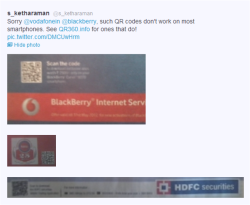Over the past 18 months or so, we’ve written several blog posts (here, here and here) about the whats, the whys and the why nots of QR codes. We’ve subsequently seen a steady stream of QR codes used in print ads by banks, insurers, real estate developers, retailers and others. There’s no doubt that this technology has entered the mainstream.
Having said that, we’re noticing a disturbing trend: Almost 50% of QR codes don’t work – as in they can’t be scanned from most smartphones using standard QR code reader apps. A few such QR codes are shown below.
We’ve also come across ads using QR code surrogates that promise an ‘augmented reality’ experience. The one below displays pictures of three banking products / features of a leading private sector bank in India and invites readers to “experience this ad with augmented reality”.
We downloaded and installed the required app on a smartphone. When we scanned each picture in the ad, we expected to be served content that was specific to the respective product / feature e.g. DIRECTCONNECT. However, what actually happened was something else: All three scans directed us to the same place i.e. homepage of the bank’s website. This is quite dumb since we could’ve entered the URL of the homepage directly on the smartphone’s http://healthsavy.com browser in a fraction of the time it took us to download and install the special app. Besides, the website is not optimized for a mobile phone.
Having covered the whats and the whys of QR codes, the aforementioned proliferation of malfunctioning QR codes suggests that it’s time to focus on the question of “how QR codes”. Here are some tips:
- The QR code should have a minimum size of 1″ x 1″ on print or 1.5″ x 1.5″ onscreen.
- The white space around a QR code is an integral part of it. Do not crop it or let it get hidden beneath something else. The best way to ensure this is to place a border around the QR code, like we do on our QR360.
- Link the QR code to a landing page that is specific to the topic on hand and optimized for a smartphone screen. Directing users to the homepage of a website, especially one that’s not mobile-optimized, will bounce them away in no time, leading to tarnishing of the brand image and negative return on your advertising dollars.
Alternatively, if you’d prefer to let the experts take care of your QR code advertising campaigns, simply head over to the landing page of our QR360 SmartResponse QR code application.


